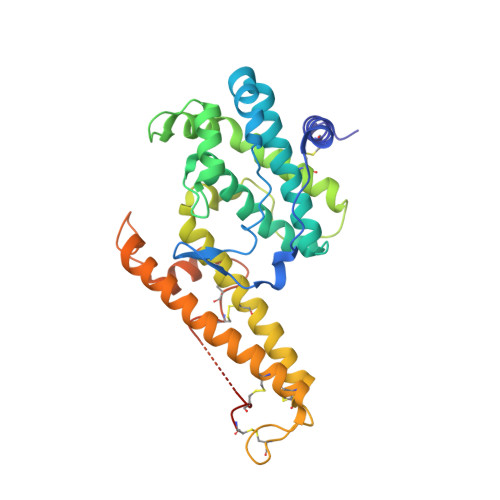Structural and Immunological Correlations between the Variable Blocks of the Var2Csa Domain Dbl6Epsilon from Two Plasmodium Falciparum Parasite Lines.
Gangnard, S., Badaut, C., Ramboarina, S., Baron, B., Ramdani, T., Gamain, B., Deloron, P., Lewit-Bentley, A., Bentley, G.A.(2013) J Mol Biology 425: 1697
- PubMed: 23429057
- DOI: https://doi.org/10.1016/j.jmb.2013.02.014
- Primary Citation of Related Structures:
2Y8D - PubMed Abstract:
Plasmodium falciparum erythrocyte membrane protein 1 (PfEMP1), a family of adhesins of the falciparum species of the malaria parasite, is exposed on the surface of the infected erythrocyte. In general, only one PfEMP1 variant is expressed at a time but switching between variants occurs, changing both host-cell receptor specificity and serotype. The PfEMP1 variant VAR2CSA causes sequestration of infected erythrocytes in the intervillous spaces of the placenta via the glycosaminoglycan chondroitin sulfate A. This leads to pregnancy-associated malaria, which has severe consequences for the fetus and mother. The extracellular region of VAR2CSA comprises six DBL (Duffy-binding-like) domains and a single CIDR (cysteine-rich inter-domain region) domain. The C-terminal domain DBL6ε, the most polymorphic domain of VAR2CSA, has seven regions of high variability termed variable blocks (VBs). Here we have determined the crystal structure of DBL6ε from the FCR3 parasite line and have compared it with the previously determined structure of that from the 3D7 line. We found significant differences particularly in the N-terminal region, which contains the first VB (VB1). Although DBL6ε is the most variable VAR2CSA domain, DBL6ε-FCR3 and DBL6ε-3D7 react with IgG purified from immune sera of pregnant women. Furthermore, IgG purified on one domain cross-reacts with the other, confirming the presence of cross-reactive epitopes. We also examined reactivity of immune sera to the four least variable VB (VB1, VB2, VB4 and VB5) using peptides with the consensus sequence closest, in turn, to the FCR3 or 3D7 domain. These results provide new molecular insights into immune escape by parasites expressing the VAR2CSA variant.
- Unité d'Immunologie Structurale, Département de Biologie Structurale et Chimie, Institut Pasteur, 25 rue du Docteur Roux, 75724 Paris, France.
Organizational Affiliation:


















